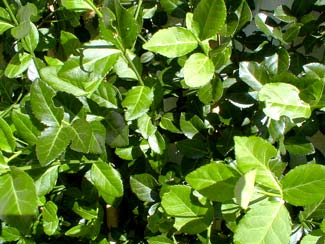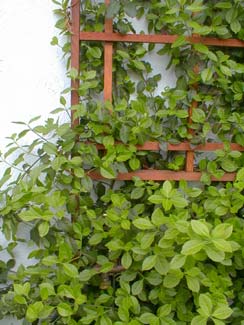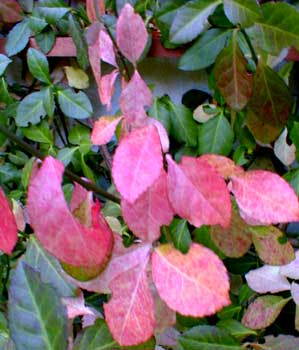
Strawberry Bush; aka,
Brook Euonymus; aka,
Hearts-a-Burstin'
I long told myself, if it were ever possible to obtain from a native plants specialist a seed-grown or cutting-started American Strawberry Bush (Euonymus americanus), derived from wild specimens of eastern to southwest North America, then that could very well prove to be a most splendid shrub for the garden. These grow three to four feet commonly, occasionally as much as ten feet tall, & produce the most remarkable autumn fruits. In the fall, four-lobed, warty, reddish purple pods open to show off large brilliantly orange seeds.
These stunning fruits develop from rather inconspicuous but appealing greenish to creamy-yellow flowers with bluish purple blush, which occur singly or in clusters in May & June.
The fruit if eaten is potentially dangerous. Bark & fruit contain the glycosides evobioside, evomonoside, & evonoside, which adds up to a powerful laxative that can at the very least cause dehydration which can alone be deadly. At worst it may have a harmful impact on the cardiovascular system. Nevertheless, Native Americans used it for sundry medicinal purposes, & deer love to browse Strawberry Bush, suffering no ill consequences.
A shrub loaded with autumn fruits is for about a month just about the showiest thing imaginable. The warty top of the umbrella-pod is pastel purple, but dark purple underneath, with its raspberry-red seeds or "strawberries" dangling under the unfolded pod. It is such an extremely fanciful-looking fruit. The common names Bursting Hearts, Hearts-a-Bustin', Hearts-a-Bursting, capture the strange beauty of the burst capsules..
If it sounds wonderful, it certainly can be. I sought out this shrub specifically for the sake of the fruit & because I believed it would fit a specific need. I wanted something I could plant in front of the faucet. Because a Strawberry Shrub can stand considerable dampness & take some wacking from hoses, yet is softly enough limbed to still reach through to access the spigot, it seemed just the thing. With its stunning fruits, it would really be worth having in such an often-visited location.
It was not easy to find a specimen, & when I did find it, it was somewhat pricy though smallish. But I had done my research & believed it was the perfect thing.
Unfortunately, what I did not realize, I was obtaining an inferior clone. The cultivated clones do not fruit the way the wild shrubs do, & since its greatest interest is the fruit, frankly these cultivated strains shouldn't be offered as substitutes. It is so easily grown from seeds & cuttings or started from suckers, there's just no excuse for marketing inferior clones that cannot perform. Or, rather, there is an excuse, but it's a sickening one. The excuse is that by the time the buyer realizes their purchase is a poor one, the profits are already in.
 The grower (or wholesaler) was Monrovia, & this was the first of a handful of times Monrovia successfully dazzled & fooled me with fancy presentation & deceptive labels. Their label praised the fruit to high heaven, but should've added, "Though of course our cultivated version will probably never have even one of those gorgeous fruits, so just basically what we are selling you is not worth one-fifth the high price we've put on it."
The grower (or wholesaler) was Monrovia, & this was the first of a handful of times Monrovia successfully dazzled & fooled me with fancy presentation & deceptive labels. Their label praised the fruit to high heaven, but should've added, "Though of course our cultivated version will probably never have even one of those gorgeous fruits, so just basically what we are selling you is not worth one-fifth the high price we've put on it."I've a separate page on Buyer Beware about my sorry experiences over the deceptive labeling practices of Monrovia. The company has a variety of great offerings mixed in with far too many lousy offerings. To peddle the latter they will lie outright on labels that describe best-variety behavior for their poor imitations.
I often felt I should root out & compost this expensive rip-off, & for some years figured I probably would do so if I could ever find a real Strawberry Shrub to replace it with. In the meantime, I tried to make the best of a poor purchase.
The first two years in the garden I kept waiting for it to begin to show the "four to six feet tall" shrub-growth the deceiving lying label promised, but the other failing of this clone is it is primarily a prostrate creeper. Wild specimens creep similarly when young, but as they age eventually begin to stand upright like a proper shrub. This clone remains eternally crawly.
 As a groundcover it did poorly under the fawcett because the dampness invited snails, & it got scrawny creeping about through the grass. After two years of suffering its profound ugliness as a second-rate ground-vine, I finally put up a trellis behind it & began espalier training. Once I got it started up the trellis, it needed very little further encouragement. By June (of 2003, as shown in the first photo up top) it had regained compact leafiness, & was so thick on the trellis that in some places the trellis was no longer visible.
As a groundcover it did poorly under the fawcett because the dampness invited snails, & it got scrawny creeping about through the grass. After two years of suffering its profound ugliness as a second-rate ground-vine, I finally put up a trellis behind it & began espalier training. Once I got it started up the trellis, it needed very little further encouragement. By June (of 2003, as shown in the first photo up top) it had regained compact leafiness, & was so thick on the trellis that in some places the trellis was no longer visible.It put on another startling flourish of leafy growth the following spring, & by summer of 2004 had crept up the wall & trellis to a startling eight to ten feet. The tough bright green leaves were finally nice enough to justify its continued presence in the garden, & today I no longer ponder rooting it out to discard. As a ground-creeper it was deplorable, & certainly failed as a shrub per se. But as a semi-evergreen climbing vine, it serves its purpose perfectly, despite that it is not capable of flowering.
Though far from the upright & flowery shrub I was misled into believing I was purchasing, it has nevertheless climbed up around the trellis & faucet & provided a complete disguise for the plumbing. The second photo (here at the right) is from the very end of March 2004, & no matter how hard you look, you won't see the faucet, yet the faucet is right there, easily accessible just by reaching my hand in there amidst the leaves.
As a rule Strawberry Bush ranges from deciduous to semi-evergreen, but ours has been nearly fully evergreen, probably because it grows against the house hence never experiences much of a winter. A friend who has the same clone but kept it in a container had the leaves turn the brightest possible scarlet late in autumn, then about half the leaves dropped in winter, with the remaining stems turning very red for the chilly months, so that even with fallen leaves it continued to have decorative value.
For several years ours never had any autumn colors to speak of, even though it's the same clone from the same Monrovia stocks obtained the same year our chum got his. So I had to assume it is the amount of chill experienced by the rhizomitous roots that causes the rich red autumn color. In autumn 2004, our strawberry bush-vine did unexpectedly take on some interesting pink, though not the bright crimson of our friend's specimen. The third photo shows some of the mid-October colors.
Most specimens would turn yellow rather than bright scarlet in autumn. There is a northern strain that turns white in autumn. There is such a variation in autumn color behavior depending both on strain & precise conditions where it is growing, as well as wide variation from deciduous to nearly evergreen, that autumn & winter behavior is not predictable before it is tested, & ours had always remained green year-round, until it had trained to climb high on a trellis & unexpectedly began to display autumn color.
It can tolerate very damp soil, selecting nearly swampy wooded shade zones in nature. Even so, older specimens long in the ground develop extensive root systems & thereby become comparatively drought hardy over time.
In autumn of 2003, a fellow gardener who read an earlier version of this page e-mailed me to ask if I wanted a start off a wild strawberry shrub, as they grew on her back property which was butted up against the John Houston National Forest. She sent me several stems with a few bare roots on them, which I dipped in rooting hormone & potted. It was almost winter & not the right season to be doing this, & I fretted the starts had died during the winter. But by the following April a few leaves appeared & it was clearly going to take. By autumn the potted shrub had become fairly leafy, & will be ready to go into its permanent location in the garden next spring.
The leaves are narrower & pointier than on the inferior clone, the branches stronger, the stance strongly upright. Lovely! And even though as I re-write this page it's too soon to have seen it fruit, there is every reason to expect it will flower perhaps as early as spring 2005, or in 2006 if it needs first to get well rooted in the garden.
Getting the wild shrub left me with a mild dilemma. I had taken a belated liking to my "creeping" strawberry shrub, due to how nicely it filled out the trellis, & no wild specimen was ever going to grow like a vine. I no longer desired to root it out to replace with a superior wild specimen. So I am rather intending to plant the upright shrub to the right of the faucet, & if I can tease a few of its limbs into the climber-clone so it looks like it's blooms too, doubly great.